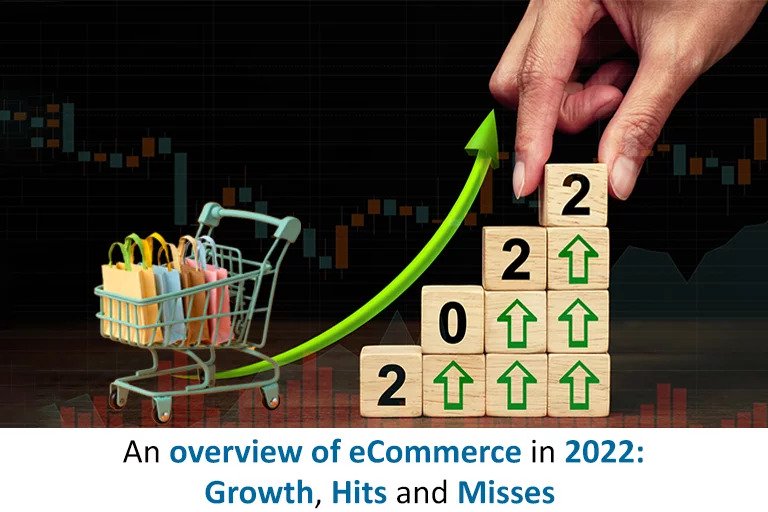The eCommerce market is constantly evolving, and this year has been no exception. Merchants are building and enhancing their eCommerce in 2022 more than ever to reach customers where they are. While everything in eCommerce is changing, we have created an overview of eCommerce in 2022.
What is meant by eCommerce?
Ecommerce refers to the buying and selling products and services through the Internet by businesses and people. It is the purchase and sale of products or services through the Internet and the movement of money and data to complete the transactions. It’s a digital platform and business strategy that allows you to purchase and sell things online. Furthermore, eCommerce in 2022 includes various activities such as online auctions, payment gateways, online tickets, and online banking.
What is the significance of trends in eCommerce in 2022?
The world of ecommerce in 2022 is becoming increasingly competitive. Keep a watch on trends to keep ahead of the competition. If you don’t stay up with ecommerce trends, no matter how mature your ecommerce shop is today, you risk slipping dramatically behind. Many of the above technologies combine in omnichannel, a type of mega trend that combines various fragmented sales channels into a single, holistic, and uniform experience throughout the company. However, no organisation is indeed “done” with omnichannel.
AR and voice search, better personalization, and other features will now be significant.
What eCommerce Trends defining 2022?
Some top trends that dominated eCommerce in 2022 are Metaverse, Artificial Intelligence, Augmented Reality, Web 3.0, Voice Search Commands, Live Streaming, Omnichannel Sales, and Chatbots. Global eCommerce sales are estimated to surpass $5 trillion in 2022, rising to $6 trillion by 2024. Merchants continue to follow consumer demand online, with record numbers flocking to the overview of eCommerce in 2022. Online retailers are regularly increasing, with an estimated 12-24 million eCommerce sites worldwide.
Overview of eCommerce in 2022 Trends
- The rise of hyper-local and lightning-fast delivery via E-commerce
Instamart is emerging as an essential player, increasing customer market share, brand expenditure, and investment. Flipkart, Dunzo, and Big Basket are all shrinking and competing on speed. 10-15x growth is projected over the next five years, but those with good finances and the ability to create sound business foundations will survive and prosper.
- Acquisition costs are rising across digital platforms
The entire cost that a corporation acknowledges on its records for property or equipment after adjusting for discounts, incentives, closing expenses, and other essential expenditures, but before sales taxes, is an acquisition cost. It is a marketing metric that calculates the overall cost of a customer performing a particular activity. Businesses can cut expenses by eliminating redundant divisions and infrastructure. Not only that, but the purchase allows the corporation to upsell or cross-sell its services or goods, raising income, etc.
- Voice recognition and vernacular languages
As India approaches the era of mass online buying, when millions of customers utilize eCommerce and direct-to-consumer (D2C) eCommerce platforms to have products delivered to their doorstep, the search bar, one of the main components of the online ordering process, is experiencing a transformation. As technology advances, eCommerce has included a voice-based search option to make searching easier. As fewer individuals in India speak English than those who do not, additional vernacular languages are being introduced to improve user experience.
- Omnichannel Marketing
Websites, apps, social media, and email are examples of online channels, as are offline channels such as brick-and-mortar retail stores or business events. It is a multichannel sales strategy that aims to give customers a seamless buying experience whether they are purchasing online from a desktop or mobile device, over the phone, or in a physical store. If this sounds complicated, consider two things.
- Visual Commerce
Two more elements that have gained popularity recently are video-enabled commerce and live commerce. With so many alternatives accessible to customers nowadays, capturing and maintaining their attention may be challenging. They constantly look for new tools and features to improve their purchase experience. Live streaming commerce, which mixes fast purchases with entertainment, is increasingly becoming the dominant mode of internet shopping.
- Product Customization
Product customization is the process of allowing customers to modify a product based on their requirements and preferences. Add-ons, special functions, templates, and product design flexibility are all examples of personalization. Customers can choose color, design, functionality, and add-on components instead of a mass-produced object. A shoe manufacturer, for example, may allow customers to create and order one-of-a-kind footwear using its web platform.
- BNPL (Buy Now, Pay Later) characteristic
Other option consumers increasingly prefer BNPL. Customers may use the BNPL function to make transactions at the push of a button instead of pulling out their credit/debit card or searching for the UPI ID. It’s also a terrific strategy to combat cart abandonment, which many customers experience as they approach the payment gateway.

